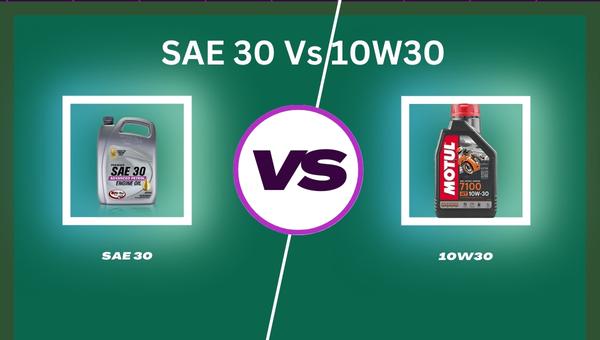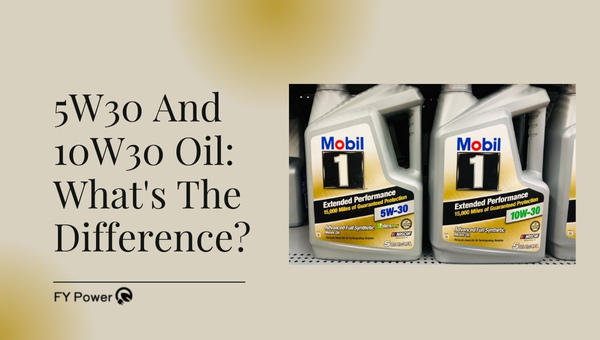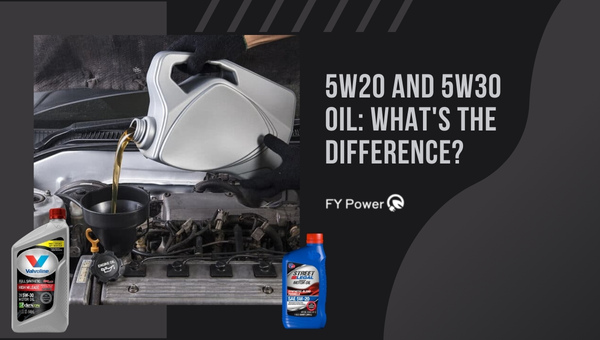Navigating the world of engine oils can feel like traversing a maze, especially when you’re trying to determine the best choice for your lawnmower or generator. You may have come across SAE 30 and 10W30 oils and wondered what the difference is between these two options.
This article aims to shed light on this topic, comparing these two oil types’ pros and cons in detail. We’ll investigate whether they are interchangeable, if they can be mixed, and their optimal weather conditions.
As we journey through this exploration together, you’ll gain an understanding that will help you make an informed decision about which oil is best suited for your machinery needs. So let’s roll up our sleeves and dive deep into the nitty-gritty of SAE 30 vs 10W30 oil – because knowing your oils can be as important as knowing your tools!
Key Takeaways
- SAE 30 oil is thicker and slower flowing, making it suitable for warm weather and single-grade engines, while 10W30 oil is a multi-grade oil that flows smoother in lower temperatures and is better for cold weather conditions and newer complex motors.
- SAE 30 oil has superior resistance to thermal breakdown and offers excellent lubrication with reduced friction between engine components, enhancing longevity. On the other hand, 10W30 oil has a reputation for longevity, high resistance to thermal breakdown, and optimal protection for lawnmowers or generators at higher speeds.
- Mixing SAE 30 oil and 10W30 oil is not recommended as it can compromise engine performance and lifespan. It is important to choose the right oil based on climate conditions and machine needs, following the user manual guidelines for maintenance schedules and oil types.
- Synthetic 5W-30 oil can be used for all temperatures in generators, and initial oil changes for generators should occur after the first 20-30 hours of operation to ensure optimal oil usage and extend the lifespan of the generators.

SAE 30 vs 10W30 Oil: What’s the Difference?
So, you’re probably wondering what exactly sets SAE 30 and 10W30 motor oils apart, right?
Imagine pouring syrup versus water on a cold winter’s morning – that’s essentially the difference in how these two oils flow at low temperatures. It all comes down to oil viscosity. The thicker the oil, like SAE 30, the slower it flows. It’s akin to molasses inching its way out of a jar; it takes its sweet time.
Now let’s consider the temperature impact on these oils. When confronted with colder conditions, SAE 30 behaves more like our syrup, as mentioned above, than an effective lubricant for your engine parts. Because of its single-grade nature, it doesn’t adapt well to fluctuating temperatures.
On the other side of the spectrum is multi-grade 10W30 oil. It has additives that allow it to flow smoother in lower temperatures while maintaining excellent lubrication efficiency across varying temps – think water effortlessly gliding over surfaces.
But remember this: both types have their merits depending on your specific needs and weather conditions at hand. You’re part of a community that values informed decisions, and we trust you’ll make the best choice for your lawn mower or generator based on this knowledge.
Also Read: 5W20 and 5W30 Oil: Difference, Uses, Shopping Guide
Pros & Cons of SAE 30 Oil
You’re about to dive into the world of SAE 30 Oil, weighing its pros and cons to understand its application better.
The Pros of SAE 30 Oil
Imagine the smooth, effortless motion of your lawn mower or generator humming along—that’s the beauty of SAE 30 oil at work.
- SAE 30 Efficiency: This non-detergent oil is known for its high efficiency in single-grade engines. It provides optimal lubrication and reduces friction between engine components, ensuring a smoother operation.
- Thermal Breakdown Resistance: SAE 30 oil exhibits superior resistance to thermal breakdown compared to multi-viscosity oils. This means it can hold up better under intense heat without losing its viscosity.
- Additive Packages: The additive packages in this type of oil help protect your engine from wear and tear, enhancing its longevity.
- Stability Under Varied Conditions: SAE 30 maintains stable performance across varied temperature conditions.
Embrace these benefits and feel part of the community that trusts SAE 30 for their machinery needs!
The Cons of SAE 30 Oil
While it’s true that every rose has its thorns, the same principle applies to SAE 30 oil with a few drawbacks to consider.
One of the main SAE 30 limitations is its performance in cold weather. The viscosity of this oil isn’t designed for low temperatures; thus, it can become too thick and struggle to flow properly within your lawn mower or generator. This means when winter rolls around, you might face issues if you’ve filled your engine with SAE 30.
Additionally, another drawback is its temperature sensitivity. Unlike multi-viscosity oils such as 10W30, which can tolerate a range of temperatures, SAE 30 isn’t quite as versatile. In fluctuating conditions, this could pose challenges to your equipment’s performance and longevity.
So while SAE 30 may feel like part of your crew in warmer climes, remember it may not always be the best teammate in colder ones.
Also Read: 5W30 and 10W30 Oil: Differences, Properties, Uses
Pros & Cons of 10W30 Oil
When choosing the right oil for your vehicle or machinery, understanding each type’s specific benefits and drawbacks is crucial.
The Pros of 10W30 Oil
Don’t you love it when your lawn mower or generator runs smoothly and efficiently? That’s exactly what 10W30 oil can offer. This particular engine oil boasts several advantages thanks to its unique viscosity. It’s thick enough to provide excellent lubrication but thin enough not to cause energy loss due to drag.
One of the key 10W30 viscosity advantages is its superior cold-weather performance. Unlike thicker oils, it doesn’t become too dense in low temperatures, ensuring your engine starts up with ease even on frosty mornings.
Moreover, this oil has a reputation for longevity. Its high resistance to thermal breakdown means that the quality of protection lasts longer, reducing the frequency of oil changes. With 10W30, you get a reliable companion for your machine’s long life journey.
The Cons of 10W30 Oil
Despite its many merits, 10W30 isn’t without a few drawbacks that could be as colossal as a mountain. For starters, let’s talk about the 10W30 viscosity issues. With overuse or under certain temperatures, this oil may lose its thickness quicker than expected. This can lead to less efficient lubrication and ultimately wear and tear on your machine parts.
Cold weather performance is another hiccup with 10W30 oil. In frigid conditions, it tends not to flow as smoothly as needed, reducing engine efficiency and making those winter tasks feel even more laborious.
Lastly are high-speed concerns. While ideal for standard use, 10W30 might not offer optimal protection for your lawn mower or generator when pushed to higher speeds. It’s a kinship we share in our community of users – wanting the best performance from our machines while keeping them well-protected.
Frequently Asked Questions
Can You Use SAE 30 Oil Instead of 10W30 Oil and Vice Versa?
Think of swapping motor oil types as dancing on a tightrope – it might work for a while, but eventually, the subtle differences can cause you to lose balance and fall. When considering replacement possibilities like using SAE 30 oil instead of 10W30 oil or vice versa in your lawn mower or generator, be aware that the oil choice impact is not trivial.
Your decision must consider the viscosity differences between these two oils. SAE 30 may not flow more easily through the engine during cold starts than its counterpart, leading to increased wear and tear. Moreover, this thicker oil could reduce fuel economy due to its resistance against flow, resulting in lower gas mileage.
The thinner SAE 10W-30 does offer better protection against engine wear by ensuring optimal lubrication under varying temperature conditions. A key detail here is that switching from the recommended oil type risks voiding your warranty should any issues arise.
Remember that manufacturers have engineered their engines for specific types of oils based on rigorous testing protocols. Their recommendations are there to ensure optimal performance and longevity for your machine.
It’s about more than just keeping your engine running; it’s about being part of a community that values care and longevity in its equipment choices.
Can You Mix SAE 30 Oil and 10W30 Oil?
Now, let’s delve into another common question you might be pondering: Can you actually mix SAE 30 oil and 10W30 oil? Technically speaking, yes, you can. However, it isn’t something that’s typically recommended. Why so? Let’s drill down into the details together.
The root of this caution lies in the concept of ‘oil compatibility.’ Simply put, SAE 30 and 10W30 oils have different viscosity levels. This divergence could potentially hamper their ability to blend properly when mixed.
Now remember, we’re all here because we care about our equipment – our lawnmowers or generators – and want them to function at peak capacity for as long as possible.
This leads us to the ‘mixing consequences.’ A poorly blended mix may still lubricate your engine but could compromise its optimal performance over time. The risk involved here is potential damage to your motor due to an inconsistent lubrication process.
So yes, while it may seem convenient or cost-effective to mix these two types of oil, consider whether it’s worth risking the health and lifespan of your machine. Your safest bet is sticking with one type for uninterrupted performance and longevity.
What Is the Ideal Weather for SAE 30 and 10W30 Oil?
Let’s unpack the ideal weather conditions for these two types of motor oil, which could certainly influence your choice depending on where you live and how temperatures fluctuate throughout the year.
The first one we’ll consider is SAE 30 motor oil. This oil thrives in consistently warm weather due to its single-grade viscosity that maintains lubrication efficiency at high temperatures. However, it loses some of its properties when the temperature drops.
- SAE 30 Oil:
- Ideal in warm climates.
- Less effective in cooler temperatures.
As for 10W30 oil, it functions well in a broader range of climates because of its multi-grade viscosity which adjusts based on the current temperature.
- 10W30 Oil:
- Versatile in various weather conditions.
- Adapts effectively to both hot and freezing temperatures.
What are the potential impacts on the engine if the wrong oil type is used?
Using the wrong oil type can impact your engine’s longevity. Oil viscosity changes can cause inadequate lubrication, leading to increased wear. The temperature impact may also affect oil flow, compromising your engine’s performance and lifespan.
Are there any specific brands that produce superior SAE 30 or 10W30 oil?
Like a trusted friend, brands such as Valvoline and Castrol offer superior SAE 30 or 10W30 oil. Their reliable products ensure long-lasting performance while minimizing environmental impact. Remember, quality oil is an engine’s lifeblood.
Can other types of oil be used in a lawnmower or generator aside from SAE 30 and 10W30?
Yes, you can use oil alternatives in your lawnmower or generator. However, consider seasonal differences and lubrication efficiency when choosing. Multi-viscosity oils like 10W-40 provide good performance across a range of temperatures.
How often should the oil in a lawnmower or generator be changed?
For optimal performance and to avoid oil contamination, change your lawnmower or generator’s oil every 50 hours of use. Seasonal considerations may also apply, so check your user manual for the best advice.
Is there a significant price difference between SAE 30 and 10W30 oils?
In terms of price comparison, there isn’t a significant difference between SAE 30 and 10W30 oils. However, depending on local prices and promotions, oil availability and budgeting considerations may influence your choice.
Conclusion
Whether you choose SAE 30 or 10W30 oil for your lawnmower or generator, it’s all about matching the oil to the weather and machine requirements.
Imagine your engine purring smoothly on a chilly morning with the right oil coursing through its veins.
Remember, it’s not just about keeping your equipment running—it’s ensuring optimal performance and longevity.
Make an informed choice; consider each oil’s pros and cons meticulously.

